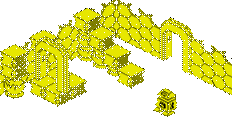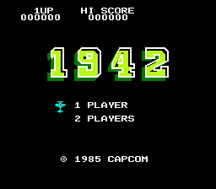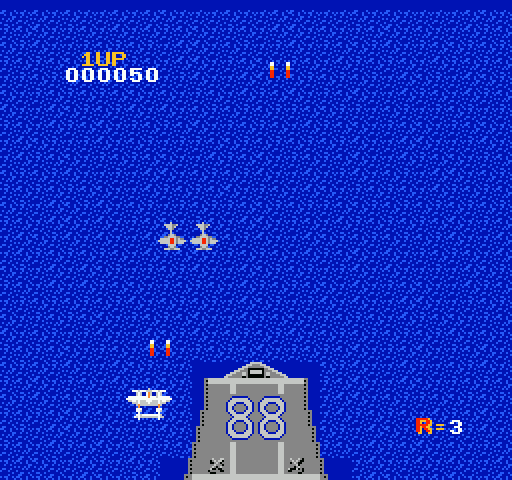1942 (1986) 




| Details (Nintendo NES) | Supported platforms | Artwork and Media | |
|---|---|---|---|
| Publisher: Genre: Author(s): Maximum Players: Joysticks: Language: Media Code: Media Type: Country of Release: Comments: |  Capcom CapcomShoot 'em Up Micronics 1-2 Standard NES controllers Eng NES-NF-USA Cartridge USA | Click to choose platform: Nintendo Game Boy Color Nintendo NES More from other publishers: Commodore Plus/4 Commodore 64 Sinclair ZX Spectrum MSX |
| Videos | Screenshots (Nintendo NES) |
|---|---|
| (no videos on file) |
Please login to submit a screenshot
| Your Reviews |
|---|
 Examiner.com (Unknown) 9th Mar 2013 08:43
Examiner.com (Unknown) 9th Mar 2013 08:43In late 1986, Capcom released a military-themed shoot-'em-up called 1942 onto the 8-bit Nintendo Entertainment System console, putting Micronics in charge of porting the game from its arcade cabinet version. As this was among the earliest shooters on the NES, and Micronics was not exactly known for the quality of its cartridges (see: Athena), the result was less than ideal.
Gameplay
This is a vertically scrolling shooter based in the setting of World War II, with the player controlling a fighter plane in a constant battle over aircraft carriers and a relentless seascape. The directional pad moves the protagonist aircraft freely all over the screen, while the B button fires and the A button executes a looping maneuver as a last-ditch desperate escape from a dangerous situation.
The best part of the game may be its power-ups. Certain more yellow-tinted little squadrons of enemy fighters will attack in a tight pattern; if the whole group can be blown to smithereens before they escape off-screen, the player is rewarded with a power-up icon. These can increase the number of rounds that get fired off at once; and, a little later, even add small “side ships” to the main craft, enabling even more fire, although at the expense of being easier to hit for enemies. Fortunately, the side-car craft can be blown away like additional hit points, leaving the primary plane to keep flying on.
True arcade gameplay style is at work here, as the goal is simply to accumulate a high score while enduring the mindless waves of enemy craft and repetitive levels. Compared to other 8-bit shooters, military-themed or set in space, 1942 is noticeably slow. From the protagonist's movement to that of enemies and even the projectiles themselves, the entirety feels like it is bogged down in a vat of syrup or something.
Now, granted, perhaps this can be used to the player's advantage. Inherently, maybe slowness purely in and of itself is not necessarily a bad thing. After all, enemy shots are easier to dodge and incoming fighters are given more time to be dealt with. But one can definitely question the appeal, here: A new player on the shooter scene would likely be attracted to faster-paced gameplay found elsewhere, while true veterans of the genre would note such delay with disdain, especially compared to other, more legendary titles on the console.
Nonetheless, 1942 does have its fans, and its slower pace could be defended as making this more of a tactical shooter. Still, when you include the slowdown that occurs when too manybut sprites overtake the screen, along with the unsmooth presentation of the animations. Really, the game feels like a poor PC title from a few years earlier.
Graphics
The previous paragraph covered 1942's visual shortcomings fairly well, and in terms of its graphics, this title has little to offer. The era-appropriate aircraft designs are neat, serving to establish the setting, but beyond those and the carrier ships, the recognizable background art of the ocean is the highlight here.
Sound
Sometimes, the soundtrack ultimately makes little difference toward a game's overall quality. Other times, the high quality of background music and effects throughout can make a game even better. In the case of 1942, though, the awful aural aspects definitely take this game down a notch or two. First of all: There is no background music. Secondly: The effects are terrible. There is a constant “siren” that goes off in an obnoxiously loud, high-pitched manner, while the sounds of weapons fire and explosions are left whispy and impotent.
Originality
While 1942 represents an early shooter and arcade port for the NES, its actual innovation is minimal, and it speaks to its low quality that future shoot-'em-ups would stray rather far from the feel and flavor of 1942. If someone wants to play a military-themed shooter on the NES, they have a better option in Sky Shark, or even the sequel, 1943: The Battle of Midway. This iteration of 1942 is just not good, ending up with one and a half stars out of five in rating.
Overall score: 1.5/5 stars.
Gameplay
This is a vertically scrolling shooter based in the setting of World War II, with the player controlling a fighter plane in a constant battle over aircraft carriers and a relentless seascape. The directional pad moves the protagonist aircraft freely all over the screen, while the B button fires and the A button executes a looping maneuver as a last-ditch desperate escape from a dangerous situation.
The best part of the game may be its power-ups. Certain more yellow-tinted little squadrons of enemy fighters will attack in a tight pattern; if the whole group can be blown to smithereens before they escape off-screen, the player is rewarded with a power-up icon. These can increase the number of rounds that get fired off at once; and, a little later, even add small “side ships” to the main craft, enabling even more fire, although at the expense of being easier to hit for enemies. Fortunately, the side-car craft can be blown away like additional hit points, leaving the primary plane to keep flying on.
True arcade gameplay style is at work here, as the goal is simply to accumulate a high score while enduring the mindless waves of enemy craft and repetitive levels. Compared to other 8-bit shooters, military-themed or set in space, 1942 is noticeably slow. From the protagonist's movement to that of enemies and even the projectiles themselves, the entirety feels like it is bogged down in a vat of syrup or something.
Now, granted, perhaps this can be used to the player's advantage. Inherently, maybe slowness purely in and of itself is not necessarily a bad thing. After all, enemy shots are easier to dodge and incoming fighters are given more time to be dealt with. But one can definitely question the appeal, here: A new player on the shooter scene would likely be attracted to faster-paced gameplay found elsewhere, while true veterans of the genre would note such delay with disdain, especially compared to other, more legendary titles on the console.
Nonetheless, 1942 does have its fans, and its slower pace could be defended as making this more of a tactical shooter. Still, when you include the slowdown that occurs when too manybut sprites overtake the screen, along with the unsmooth presentation of the animations. Really, the game feels like a poor PC title from a few years earlier.
Graphics
The previous paragraph covered 1942's visual shortcomings fairly well, and in terms of its graphics, this title has little to offer. The era-appropriate aircraft designs are neat, serving to establish the setting, but beyond those and the carrier ships, the recognizable background art of the ocean is the highlight here.
Sound
Sometimes, the soundtrack ultimately makes little difference toward a game's overall quality. Other times, the high quality of background music and effects throughout can make a game even better. In the case of 1942, though, the awful aural aspects definitely take this game down a notch or two. First of all: There is no background music. Secondly: The effects are terrible. There is a constant “siren” that goes off in an obnoxiously loud, high-pitched manner, while the sounds of weapons fire and explosions are left whispy and impotent.
Originality
While 1942 represents an early shooter and arcade port for the NES, its actual innovation is minimal, and it speaks to its low quality that future shoot-'em-ups would stray rather far from the feel and flavor of 1942. If someone wants to play a military-themed shooter on the NES, they have a better option in Sky Shark, or even the sequel, 1943: The Battle of Midway. This iteration of 1942 is just not good, ending up with one and a half stars out of five in rating.
Overall score: 1.5/5 stars.
 (Anonymous) (Unknown) 10th Nov 2012 07:43
(Anonymous) (Unknown) 10th Nov 2012 07:43| Cheats | Trivia |
|---|---|
| There are no cheats on file for this title. | No trivia on file for this title. |
History
This title was first added on 15th October 2011
This title was most recently updated on 9th March 2013










